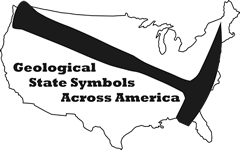Vermont
State Rock #1: Granite
State Rock #2: Marble
Marble is a metamorphosed variety of the sedimentary rock limestone. This means that the original sedimentary rock underwent periods of increased temperatures and pressures to change the rock itself. The primary minerals in marble are calcite (CaCO3) or dolomite ((Ca,Mg)CO3) but it will usually have other mineral contaminates mixed in as well (i.e., clay, mica, quartz, pyrite, and iron oxide, etc.). Since, the primary mineral in marble is calcite, most marbles will have a white color with swirls of darker colors (the contaminates) but marbles can be found in many different colors depending on what impurities were present in the initial limestone. During metamorphism of the original limestone, the calcite is recrystallized to form interlocking crystals, which will usually destroy any remnants of the original rock, including any fossils present.
Related: Alabama State Rock - Marble; Colorado State Rock - Yule Marble
State Rock #3: Slate
State Mineral: Talc
State Gem: Grossular Garnet
Garnet is typically thought of as one specific mineral, however garnet is actually a series of very similar minerals. This mineral series varies in chemical composition, resulting in different mineral names, however the chemical composition of all of the garnets share a generalized chemical composition: X3Y2(SiO4)3, where "X" can be Ca, Mg, Fe2+, or Mn2+, and "Y" can be Al, Fe3+, Mn3+, V3+, or Cr3+. Along with the different chemical compositions, there are different colors and hardnesses associated with each one as well. Crystals of garnet typically form in 12-sided "balls", that can be easy to identify within the rocks that they are found in. The name "garnet" comes from the Latin, "granatus" meaning "like a grain" because of this ball-crystal habit. Garnet is formed from the metamorphism of shale minerals, and can be found in most foliated metamorphic rocks such as schist and gneiss. Garnets can also be found in some igneous rocks including granites and granitic pegmatites. Garnet has been used as a gemstone since ancient Egypt, however recently garnet has obtained significant usage as an abrasive. Since garnet is a rather hard mineral and has no cleavage, it typically breaks into sharp edged fragments, and therefore produces a good grit for water-jet cutting or sandblasting. Garnet is a very common mineral and even high grade gemstone quality specimens can be fairly cheap.
Related: Connecticut State Mineral - Almandine Garnet; Idaho State Gem - Star Garnet; New York State Gem - Garnet
State Marine Fossil: Beluga Whale Skeleton
Related: Alabama State Fossil - Basilosaurus cetoides
State Terrestrial Fossil: Mount Holly Mammoth Tooth & Tusk
Related: Alaska State Fossil - Woolly Mammoth (Mammuthus primigenius); Nebraska State Fossil - Mammoth; South Carolina State Fossil - Columbian Mammoth; Washington State Fossil - Columbian Mammoth
References
https://statesymbolsusa.org/states/united-states/vermont
Geology of Vermont's National Parks
Through Pictures
(at least the one's I have been to)
None yet!


